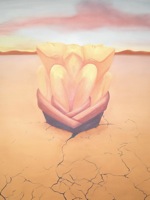Difference between revisions of "Surrealism"
(Created page with 'File:lighterstill.jpgright|frame ==Etymology== back-formation from surrealism Date: [http://www.wikipedia.org/wiki/1930's 1937] ==Definition== *1 : ma...') |
m (Text replacement - "http://" to "https://") |
||
| (One intermediate revision by one other user not shown) | |||
| Line 3: | Line 3: | ||
==Etymology== | ==Etymology== | ||
back-formation from surrealism | back-formation from surrealism | ||
| − | Date: [ | + | Date: [https://www.wikipedia.org/wiki/1930's 1937] |
==Definition== | ==Definition== | ||
*1 : marked by the [[intense]] [[irrational]] [[reality]] of a [[dream]]; also : unbelievable, fantastic <surreal sums of [[money]]> | *1 : marked by the [[intense]] [[irrational]] [[reality]] of a [[dream]]; also : unbelievable, fantastic <surreal sums of [[money]]> | ||
| Line 9: | Line 9: | ||
'''Surrealism''' is a [[cultural]] [[movement]] that began in the early 1920s, and is best known for the [[visual]] artworks and [[writings]] of the [[group]] members. | '''Surrealism''' is a [[cultural]] [[movement]] that began in the early 1920s, and is best known for the [[visual]] artworks and [[writings]] of the [[group]] members. | ||
| − | Surrealist works feature the element of [[surprise]], unexpected [[juxtaposition]]s and non sequitur; however, many Surrealist [[artists]] and [[writers]] regard their [[work]] as an [[expression]] of the [[philosophical]] [[movement]] first and foremost, with the works being an [[artifact]]. Leader [ | + | Surrealist works feature the element of [[surprise]], unexpected [[juxtaposition]]s and non sequitur; however, many Surrealist [[artists]] and [[writers]] regard their [[work]] as an [[expression]] of the [[philosophical]] [[movement]] first and foremost, with the works being an [[artifact]]. Leader [https://en.wikipedia.org/wiki/Andr%C3%A9_Breton André Breton] was explicit in his [[assertion]] that Surrealism was above all a [[revolutionary]] [[movement]]. |
| − | Surrealism [[developed]] out of the [ | + | Surrealism [[developed]] out of the [https://en.wikipedia.org/wiki/Dada Dada] activities of [[World War I]] and the most important [[center]] of the movement was [https://en.wikipedia.org/wiki/Paris Paris]. From the 1920s on, the movement spread around the globe, [[eventually]] affecting the [[The Arts|visual arts]], [[literature]], [[film]] and [[music]] of many countries and [[languages]], as well as [[political]] [[thought]] and [[practice]], [[philosophy]] and [[social]] [[theory]].[https://en.wikipedia.org/wiki/Surrealism] |
[[Category: The Arts]] | [[Category: The Arts]] | ||
Latest revision as of 02:35, 13 December 2020
Etymology
back-formation from surrealism Date: 1937
Definition
- 1 : marked by the intense irrational reality of a dream; also : unbelievable, fantastic <surreal sums of money>
Description
Surrealism is a cultural movement that began in the early 1920s, and is best known for the visual artworks and writings of the group members.
Surrealist works feature the element of surprise, unexpected juxtapositions and non sequitur; however, many Surrealist artists and writers regard their work as an expression of the philosophical movement first and foremost, with the works being an artifact. Leader André Breton was explicit in his assertion that Surrealism was above all a revolutionary movement.
Surrealism developed out of the Dada activities of World War I and the most important center of the movement was Paris. From the 1920s on, the movement spread around the globe, eventually affecting the visual arts, literature, film and music of many countries and languages, as well as political thought and practice, philosophy and social theory.[1]
